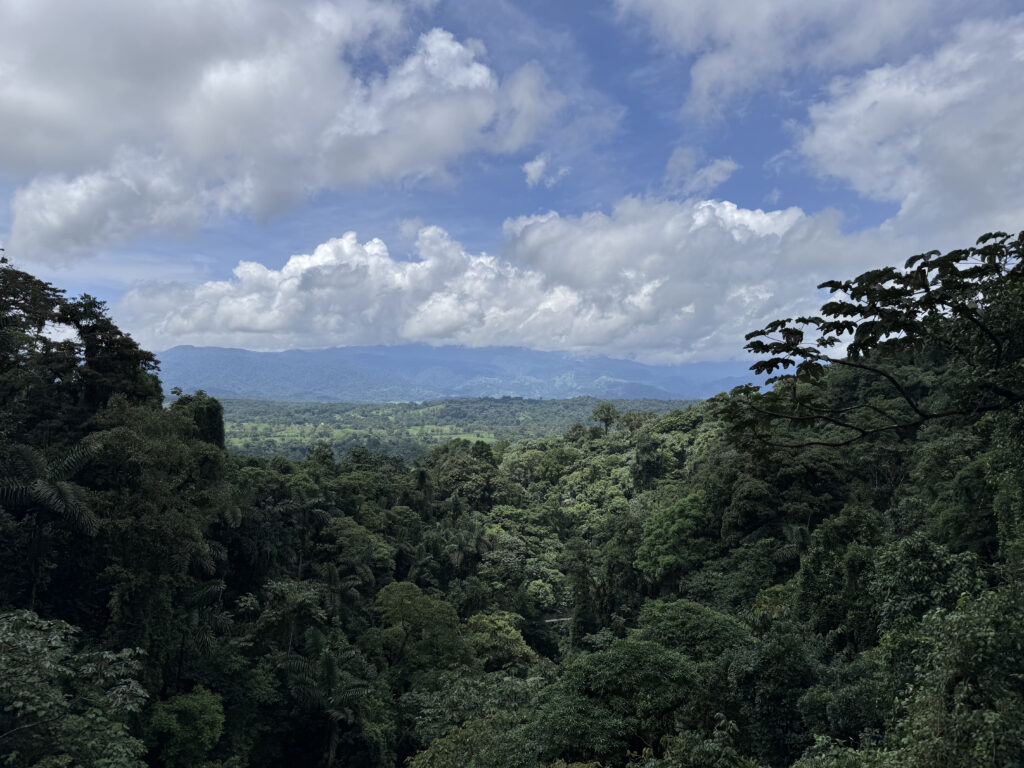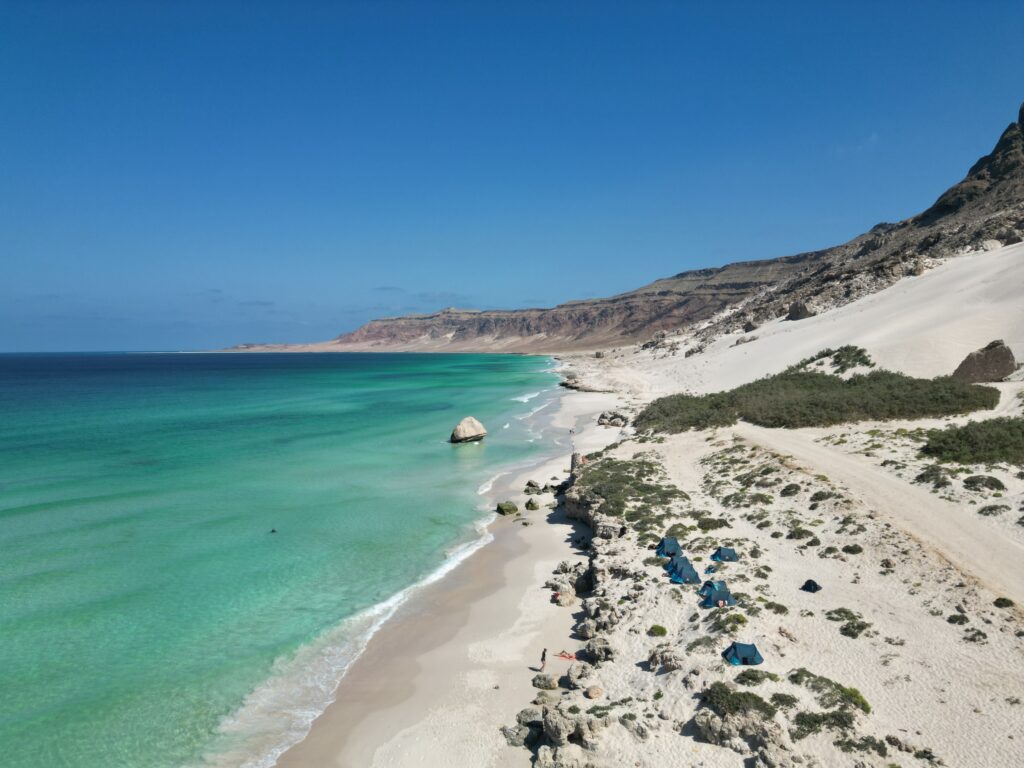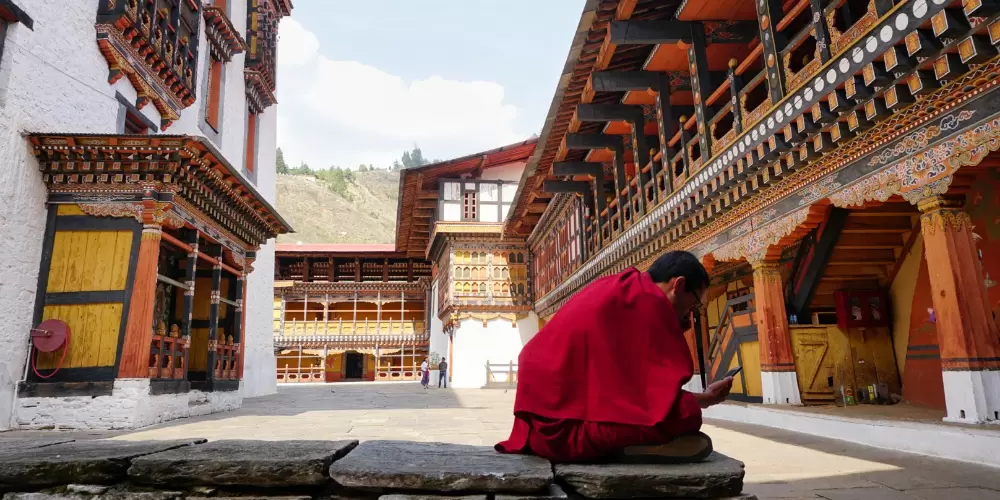Costa Rica is internationally regarded as a leader in the field of environmental and nature conservation. The country is renowned for its unique biodiversity, progressive reforestation policy and almost complete switch to renewable energy. This status is not only due to its natural wealth, but above all to years of consistent environmental policy and a deep-rooted social awareness of ecology.
What makes Costa Rica truly sustainable
That is also one of the reasons why I visited Costa Rica with my family in the summer of 2024. We were attracted by its reputation as a sustainable leader. We traveled to Costa Rica with the aim of not only seeing nature, but also experiencing how the people here have been interacting with their environment for generations.
What immediately struck me was how guides here are not just tour guides, but true nature educators who pass on their passion and knowledge. Traveling through the country, you immediately experience where that reputation comes from, but you also see up close where it is under pressure.
To gain more insight into this, I spoke with Ed, who has lived in Costa Rica for twenty years. In our conversation, it was immediately apparent how clearly and pragmatically he speaks about a topic that often remains abstract. His conviction does not come from theory, but from everyday practice.
In addition to his work in horticulture, he founded Edventure Reizen, which has developed into one of the most sustainable tour operators in the country. With his off-the-beaten-track tours, he takes visitors to places where sustainability is not a slogan, but everyday practice. Ed is also co-initiator of the Green Circle Experience, a network of lodges and projects that sets a new standard for sustainable tourism in Costa Rica.

Strategic policy as a foundation
Costa Rica’s environmental reputation is based on decades of policy that prioritized nature conservation over military or industrial expansion. “Costa Rica has not had an army since 1948,” says Ed. “This has freed up resources for education, healthcare, and sustainable development. That makes this country unique in the region.”
One of the most visible results is the reforestation policy. In 1988, only 23 percent of the land area was forested. “Today, that figure is 56 percent,” says Ed. “That is no coincidence, but the result of consistent policy. In particular, thanks to the appointment of the first environment minister and the fact that this policy has hardly changed since then.”
The country is also a leader in the field of energy supply. For more than twelve years, 99.5 percent of electricity has been generated from renewable sources. “Access to energy, healthcare, and telephony is well organized here,” Ed emphasizes. “That social basis is just as important as the ecological side.”
Costa Rica has received international recognition for its sustainable course, including the UN Champion of the Earth Award. Sustainability is also embedded in brand strategy. The national brand Essential Costa Rica links economic promotion directly to ecological values, with an emphasis on quality, innovation and responsible tourism.
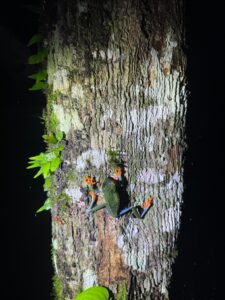
In practice: sustainable tourism at the local level
Edventure Reizen is a good example of how local initiatives in Costa Rica are putting sustainable tourism into practice. What started as a small-scale organization without a marketing budget has grown into a pioneer in travel with a minimal ecological footprint. Ed focused on independent travelers and developed the Green Circle Experience: a network of five lodges where nature restoration, biodiversity protection and local involvement are central.
One of these lodges is Maquenque Eco Lodge, located deep in northern Costa Rica, near the border with Nicaragua. The site is situated in the middle of a 60-hectare private reserve, which is part of a crucial ecological corridor between the Maquenque Wildlife Refuge and the Indio-Maíz reserve in Nicaragua. More than 400 bird species have been observed here, including the endangered green macaw. The lodge is built with natural materials, runs on solar energy, and works closely with local farmers and communities.
What makes Maquenque so special is that it is a form of regenerative tourism, an approach in which travel not only causes less damage but also actively contributes to nature restoration. This area was once intensively used for livestock farming. Now it has been redesigned as a nature reserve that restores flora and fauna and provides employment through ecotourism.
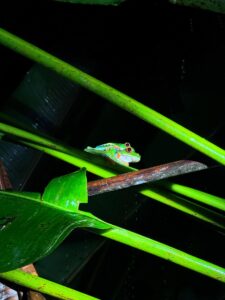
“It’s not about the terms,” says Ed. “It’s about what you do. Giving land back to nature. Involving local people. Facilitating education. And making sure that as a visitor, you leave behind something bigger than your footprint.”
During my trip, I also stayed at Finca Surá, a sustainable pineapple and cocoa farm in Sarapiquí, in the community of Linda Vista de Chilamate. We slept in simple cabins surrounded by lush nature. Accompanied by the owner, we walked through fields full of fragrant herbs and fruit trees, and along the way we saw butterflies, birds, and brightly colored frogs in the wild.
Afterwards, I realized how natural the connection between ecology and hospitality feels here. For my children, spotting brightly colored frogs in the night rain was a great adventure. For me, it felt like temporarily being part of a living ecosystem, a place where, as a visitor, you also become a student.
As Ed sharply points out: “Sustainable travel doesn’t stop at the overnight stay. Transportation and the environment must also be part of the solution.”
With initiatives such as electric shared cars, strategically placed at lodges within the Green Circle, and collaborations with sustainable farms, Edventure shows how sustainable tourism can be more than just a label. It becomes an experience that touches you and stays with you.
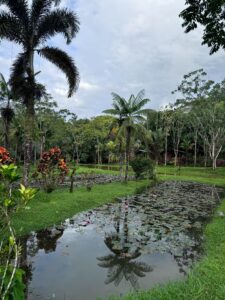
Increasing pressure from tourism and investments
Despite the strong foundation, the balance between tourism and sustainability is beginning to falter. According to Ed, a clear shift has been visible in recent years. “Visa policy has been relaxed, foreign investors are buying up land on a large scale in tourist regions and nature corridors. Prices are rising, infrastructure is not keeping pace, and many local residents are being displaced.”
What once seemed like a carefully regulated model is changing due to gentrification. “Americans and Canadians are buying up coastal strips and plots of land, while Costa Ricans are increasingly moving inland because their living environment is becoming too expensive,” says Ed. This development not only affects the quality of life, but also social cohesion in tourist areas. What also struck me was how committed many guides and small business owners are to preserving their country. They act as bridge builders between tourists and nature, but are also under pressure from growing tourism and changing economic interests.
During my stay, I spoke with Costa Ricans who worked at the accommodations where we stayed. They told me how difficult it has become for many people to make ends meet financially. They pay the same high supermarket prices as tourists, often need two jobs to support their families, and have to live further and further away from tourist areas due to rising costs. This means long commutes and less connection to their workplace or community. What struck me personally was how high supermarket prices are. Many products were even more expensive than in the Netherlands, a striking contrast in a country where the average wage is considerably lower.
Ed views this trend with concern. “Tourism is increasingly about money, and that comes at the expense of the original idea of sustainability. Many hotels put an eco-label on their facade, but their business practices are anything but sustainable.”
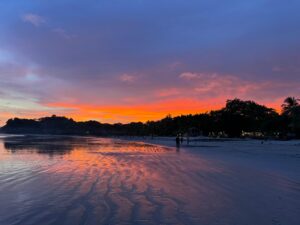
A new generation and the danger of greenwashing
The growth of tourism in Costa Rica brings not only economic opportunities but also tensions. While some parts of the country are flourishing, the gap between local communities and the tourism sector is threatening to grow. At the same time, there is a new generation of Costa Ricans who are conscious and well-educated and are trying to develop new forms of tourism in which community spirit, cultural preservation, and ecology are once again central.
According to Ed, it is often small-scale initiatives that are leading the way in this regard. “In villages where young people are now learning English and building their own guesthouses or selling handicrafts, you can see that tourism is contributing to local development. Indigenous communities are creating their own educational and ecotourism programs. They remain owners of their land and their story.”
But these positive initiatives are under pressure due to the lack of clear rules. “There is a proliferation of eco-labels,” says Ed. “Everyone calls themselves sustainable, but there is little control. Greenwashing is a big problem. If tourism is only about marketing and profit, you lose what makes Costa Rica unique.”
That observation ties in with my own experience: where sustainability is truly experienced, such as at an agro-ecological farm or a lodge in a restored nature reserve, you feel that you are part of something that goes beyond a vacation. But in other regions, I also saw how “eco” has mainly become a selling point, without the practice living up to it.
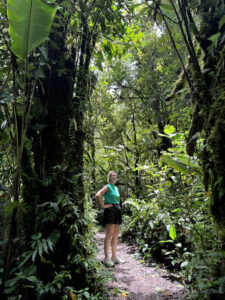
What Costa Rica really teaches us
The lesson from Costa Rica is not that sustainability comes naturally. On the contrary: a country that is internationally praised for its ecological policy must continuously invest in order to live up to its guiding role. The infrastructure and policy may be progressive, but success is fragile and the balance is delicate.
For travelers, this means that conscious choices are more important than ever. Not only where you sleep, but also how you travel, with whom you share your money, and what forms of tourism you encourage. Staying at an agro-ecological farm or a lodge that is part of an ecological corridor not only enriches your experience, but also contributes to the future of the country.
Costa Rica shows that sustainable tourism only works if it is holistic: when ecology, economy, social justice, and culture come together. As soon as one of these elements dominates, as is increasingly the case with the economy, the balance is threatened. This affects not only the inhabitants, but ultimately also the appeal of the country itself.
During conversations with guides and residents, it became clear to me how deeply rooted the sense of responsibility for nature is here. This personal connection is perhaps the most valuable thing Costa Rica has to offer. Because ultimately, it is the inhabitants who care for the soul of a country. They impart to you, as a traveler, the norms and values about how we treat nature and animals. They are the guardians of the daily balance. For me, their ability to live, reside, and work well is a prerequisite for sustainable tourism.
Ed puts it aptly: “We want people to experience Costa Rica as it is meant to be: pure, unspoiled, and full of wonder. But that is only possible if travelers also understand how vulnerable this place is and take responsibility for its preservation.”
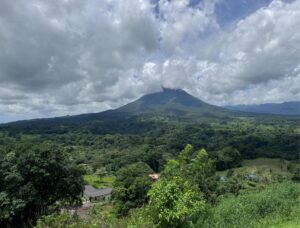
Experiencing nature as an integral part of citizenship
What sets Costa Rica apart from many other destinations is that environmental awareness is instilled from an early age. In school, children learn about ecosystems, biodiversity, and the impact of human behavior. This translates into how parks are managed, how guides operate, and how residents interact with visitors.
Tourists are actively informed about rules of conduct: stay on the paths, do not take plants or shells, treat animals with respect. These clear frameworks make nature conservation a shared responsibility, supported by the government, citizens, and visitors.
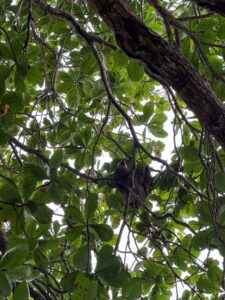
Policy under pressure: the shift from vision to revenue model
For decades, Costa Rica has benefited from political stability and consistent policies that prioritized ecology, education, and social development. It was precisely this long-term vision that made the country a leader in nature conservation. But according to Ed, that course is beginning to shift. “Exceptions have been made to building restrictions in protected mangrove areas, and it has become easier for foreigners to buy land,” he says. “That jeopardizes the balance.”
The tension between the short and long term is becoming increasingly apparent. Whereas Costa Rica was once known for its integrated approach to sustainability, with room for ecological, economic, social, and cultural values, economic growth is now increasingly being prioritized. The emphasis on returns, real estate, and tourism investments threatens to come at the expense of nature conservation and local control.
“Costa Rica’s reputation rests on choices,” says Ed. “If those choices change, so does the narrative.”
And that story is fragile. Because if tourism no longer delivers on its promise of broad prosperity, the model will lose its support. Gentrification, cultural impoverishment, and social inequality will then become not unintended side effects, but structural features of an unbalanced system.
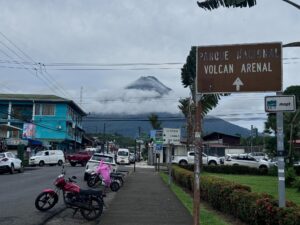
Lessons for other destinations
Costa Rica’s experience offers valuable insights for other regions striving for sustainable tourism. Not as a blueprint, but as a living example of what is possible and what can go wrong if the balance is lost. Five lessons stand out:
1. Long-term policy works – provided you stick with it
Costa Rica’s success with reforestation, clean energy, and environmental education is no coincidence. It is the result of decades of consistent policy that transcended party politics. Destinations that take sustainable ambitions seriously should not think in terms of three-year projects, but in terms of generations. Without policy continuity, any sustainable foundation will sooner or later fall apart.
2. Sustainable tourism requires local ownership
If tourism creates economic value, that value must also continue to circulate locally. This means giving space to local entrepreneurs, involving residents in decision-making, and making communities co-owners of the tourism product. Only then can support and resilience be created. When decisions come from above or from outside, the risk of resistance, inequality, and ultimately loss of authenticity increases.
3. Integral thinking is a necessity
Too often, sustainability is reduced to visible ecological interventions: solar panels, waste separation, nature conservation. But sustainability is not the sum of individual measures. Without attention to social justice and cultural heritage, ecology remains superficial and vulnerable. Sustainable tourism requires systems thinking: the realization that nature, people, economy and culture are inextricably linked. Only when we see, understand, and appreciate these connections can we create a model that is sustainable in the full sense of the word.
4. Reputation requires transparency
Costa Rica has a strong international reputation as a sustainable country. But that reputation is only credible if the downsides are also acknowledged: gentrification, loss of local control, the risk of greenwashing. The same applies to other destinations: those who present themselves as sustainable must also be open about dilemmas, tensions and choices. That inspires confidence and respect.
5. Limit dependence on foreign investors
External investments can be valuable, but they also carry risks. When land ownership, decision-making, and profit flows increasingly lie outside the local community, a destination loses control over its own development. A robust tourism model is therefore not only ecologically and socially sustainable, but also economically resilient and locally rooted.
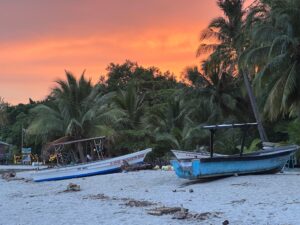
Maintaining balance: an ongoing challenge
Costa Rica shows what is possible when nature, policy, and society work together in a sustainable direction. At the same time, the country also shows how vulnerable that model is when economic interests take precedence.
Costa Rica’s reputation as a leader in nature conservation is well deserved. But that reputation cannot be taken for granted. Only when residents, nature, and policy continue to develop in harmony can Costa Rica remain the sustainable destination it wants to be and hold up as an example to the world.
Isabel Mosk is a tourism strategist and founder of Sherpa’s Stories. She has worked for more than 50 destinations worldwide and specialises in tourism trends, strategy, positioning and storytelling.

